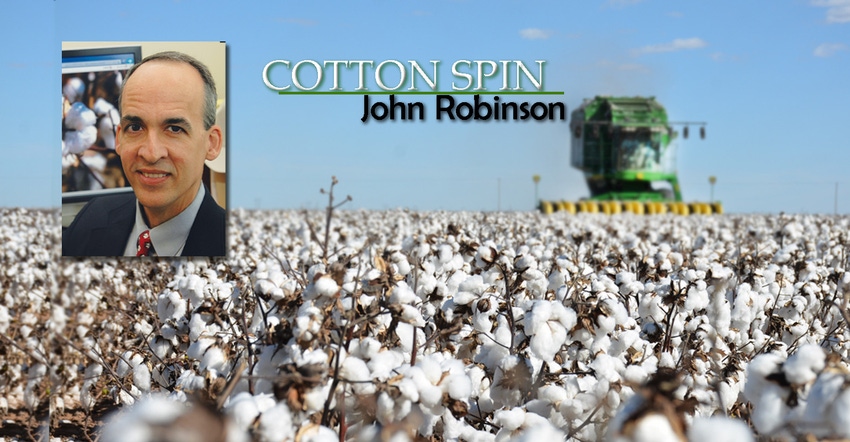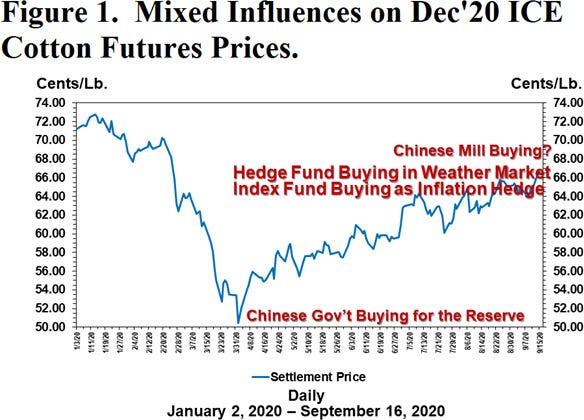
For what it’s worth, the September supply/demand numbers from USDA were price supporting in their monthly adjustment, but remain bearishly high in their resulting levels.
The world cotton balance sheet reflected tightening after a flurry of offsetting adjustments. On the supply side, world beginning stocks were 1.12 million bales fewer compared to August, mostly in India. Further, the September estimate of world production was lowered 330,000 bales, month over month. The reduced production resulted from a big cut in the U.S. (-1M bales) plus Pakistan (-300,000) and Turkey (-200,000) that outweighed increases in China (+750,000), India (300,000), and Australia (+200,000).
World cotton imports and exports were raised 170,000 and 130,000 bales, respectively. A 360,000-bale month-over-month cut in world consumption was spread over the U.S., Brazil, and Mexico. The supply reductions dominated the other changes resulting in 1.07 million fewer bales of world ending stocks, which is fundamentally neutral/bullish in terms of the monthly adjustment. The resulting level of 103.84 million bales is still historically bearish. It’s going in the right direction, but it’s got a long way to go.
The U.S. adjustments reflected a similar story. The U.S. cotton balance sheet adjustments started with 50,000 more bales of 20/21 carry-in, raising it to 7.25 million bales. This carry-in is perhaps the most fixed and bearish aspect of the U.S. balance sheet. U.S. all cotton planted acreage for the 2020 crop was cut 70,000 acres. U.S. 2020 crop abandonment was raised from 24% to 26% (which is the fourth highest in 20 years). However, abandoning a lot of dryland on the southern plains helped maintain a high national average yield per harvested acre (i.e., it only dropped month-over-month from 938 to 910 pounds per acre). These reinforcing effects combined to decrease U.S. new crop production from 18.03 million to 17.06 million bales.
See, Russian wheat prices $0.86 higher than last year
The cut to production resulted in fewer exportable surpluses, hence USDA decreased their estimate of U.S. exports was by 400,000 bales, month over month. Lastly, U.S. mill use was lowered 200,000 bales. The bottom line of all these adjustments was a trimming of new crop ending stocks from 7.6 million to 7.2 million bales. Again, this tightening is moving in the right direction, but still at a bearishly high level. The resulting stocks-to-use ratio likewise remains above the burdensome 40% threshold level, which is fundamentally price weakening according to history and economic theory.
Yet despite these numbers, ICE cotton futures keep working higher, as they have done since the early April pandemic recession lows (Figure 1). The first impetus to support the market was policy driven, i.e., Chinese government buying of U.S. cotton for their strategic reserve. Such buying supports China’s commitment to buy certain U.S. products under the Phase One Agreement. The resulting import demand coincided with a rise in Dec. 2020 futures back above 60 cents.

As the summer progressed, hedge funds covered their short positions and built a net long speculative position, apparently betting on a smaller crop and higher prices. This weather market effect may have run its course with the benchmark September WASDE behind us. At the same time, index funds increased their net long position, perhaps in response to rising inflation expectations created by the money printing of central banks. The combined speculative buying of these two groups coincided with the market’s repeated attempts to break through the mid-60s range (Figure 1).
Another emerging issue, also policy driven, involves China’s reaction to sanctions on exports of cotton, yarn, and apparel from Xinjiang Province. The U.S. has announced sanctions in response to Chinese treatment of the majority Uyghur population. Now, Xinjiang is the source of 85% of China’s domestic cotton production. If the U.S., and perhaps the European Union, ban cotton products from Xinjiang, then China might have to re-route it’s entire textile industry, using Xinjiang cotton for domestic Chinese consumption, and buying more foreign imports to support its export-focused textile industry. That means China might be importing more foreign cotton, including U.S. cotton (which again supports China’s Phase One commitment).
But all this remains to be seen. There are lots of ifs in this unfolding situation, and the proof will be in sustained, large new export sales of U.S. cotton to China. The market will be watching.
For additional thoughts on these and other cotton marketing topics, please visit my weekly on-line newsletter at http://agrilife.org/cottonmarketing/.
About the Author(s)
You May Also Like




